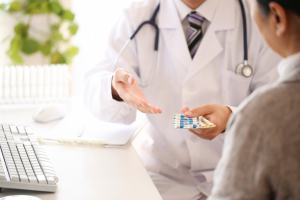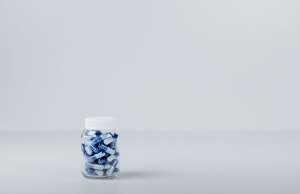The discovery of antidepressants was literally a happy accident. In 1952, scientists were trying to treat tuberculosis with a drug called isoniazid, and their patients became inexplicably euphoric. By the end of the 1950s, almost half a million psychiatric patients were being treated with isoniazid, the world’s first prescription antidepressant.
Depression medications have come a long way since the 1950s. For one, isoniazid was shown to cause liver damage, and a number of better formulations took its place. But there’s still a lot of progress that needs to be made. In many cases, researchers know that these anti depression meds work, but they don’t know exactly why they work. Major depressive disorder (MDD) is a complex mental health condition that scientists are still trying to understand – at least from a biochemical standpoint.
This article will take an honest look at what experts know and don’t know about medications for depression. We’ll try to answer all your basic questions about antidepressant drugs and alternative depression treatments so you can have an informed conversation with your doctor. And if you are suffering from depression, we hope to inspire you to seek the help you need, whether that support includes medication or not.

How Many People Take Antidepressants?
Before antidepressant drugs went on the market, treatments for major depression included lobotomies, stays in “lunatic asylums,” amphetamines, and opioids. And in fact, depression was considered relatively rare in the US until the 1970s, affecting far fewer people than anxiety, which was liberally treated with tranquilizers. But in 1975 depression diagnoses exceeded anxiety diagnoses by five million cases. And by the year 2000, one out of every 10 Americans was taking an antidepressant.
As for more recent data, the Centers for Disease Control and Prevention (CDC) state that during the years 2015-2018, 17.7% of American women and 8.4% of American men reported taking antidepressant medications within the previous month. Antidepressants aren’t just prescribed for depression, however. Some of these meds can be used to treat anxiety disorders, chronic pain, eating disorders, alcohol dependence, and even obsessive-compulsive disorder (OCD). We’ll get into specific depression drugs and their applications in the section below.
Depression Medication List
The depression pharmaceutical industry is booming, with new formulations and drug targets emerging every year. Here’s a comprehensive summary of what’s available by prescription and over-the-counter (OTC). We’ll also take a look at future treatment directions.
5 Drug Classes of Antidepressant
Antidepressants are often categorized by class (there are 5 main antidepressant groups) and/or generation (first generation, second generation, and third generation antidepressants). Drug recommendations can vary from country to country. This section will focus on the antidepressants that the Food and Drug Administration (FDA) has approved to treat major depressive disorder (MDD) in the United States. The following medications are listed first by their generic drug name, then in parentheses by brand name. You can read more about how these depression medications work in a section below.
1. Selective serotonin reuptake inhibitors (SSRIs)
- fluoxetine (Prozac)
- sertraline (Zoloft)
- citalopram (Celexa)
- escitalopram (Lexapro)
- paroxetine (Paxil)
- paroxetine controlled release/CR (Paxil CR)
- fluvoxamine (Luvox)
2. Serotonin-norepinephrine reuptake inhibitors (SNRIs)
- venlafaxine (Effexor)
- venlafaxine extended release/XR (Effexor XR)
- desvenlafaxine (Pristiq)
- duloxetine (Cymbalta)
- levomilnacipran (Fetzima)
- milnacipran (Savella)
3. Tricyclic antidepressants (TCAs)
- amitriptyline (Elavil)
- imipramine (Tofranil)
- clomipramine (Anafranil)
- doxepin (Sinequan)
- nortriptyline (Pamelor)
- desipramine (Norpramin)
- amoxapine (Asendin)
- maprotiline (Ludiomil)
- trimipramine (Surmontil)
- protriptyline (Vivactil)
4. Monoamine oxidase inhibitors (MAOIs)
- tranylcypromine (Parnate)
- phenelzine (Nardil)
- selegiline (Emsam)
- isocarboxazid (Marplan)
5. Atypical antidepressants
- trazodone (Oleptro, Desyrel)
- vortioxetine (Brintellix)
- mirtazapine (Norset, Remeron, Avanza, Zispin)
- bupropion (Wellbutrin)
- vilazodone (Viibryd)
- nefazodone (Serzone)
- brexanolone (Zulresso), an infusion for postpartum depression (PPD)
Antidepressant Adjuncts
If a single antidepressant (monotherapy) isn’t having the desired effect, then mental health professionals may try another antidepressant, which is called a switching strategy. If that doesn’t work to relieve symptoms, a clinician may prescribe two medications. This is especially common in cases of treatment-resistant depression (TRD). When two or more antidepressants are prescribed, it’s called a combination strategy. When a non-antidepressant medication like an antipsychotic is prescribed in addition to an antidepressant, it’s called an augmentation strategy. Here are some of the adjuncts and pairings that are available for depression treatment in the US:
Adjuncts
- aripiprazole (Abilify)
- brexpiprazole (Rexulti)
- lumateperone (Caplyta)
- lurasidone (Latuda)
- olanzapine (Zyprexa)
- quetiapine (Seroquel)
- risperidone (Risperdal)
Less common adjuncts include lithium, certain antipsychotics, the thyroid hormone triiodothyronine, and stimulants like d-amphetamine.
Combinations
- amitriptyline/chlordiazepoxide (Limbitrol)
- amitriptyline/perphenazine (Etafron)
- flupentixol/melitracen (Deanxit)
- olanzapine/fluoxetine (Symbyax)
- tranylcypromine/trifluoperazine (Parstelin, Parmodalin, Jatrosom N, Stelapar)
Other Depression Medications
Many more investigational antidepressants are under development for the treatment of MDD, TRD, bipolar depression, and postpartum depression. Ketamine seems to hold promise as a quick-acting, off-label medication. The FDA has already approved a fast-acting nasal spray called esketamine, aka (S)-ketamine (Spravato), for the treatment of depression. Esketamine is derived from ketamine, a controlled substance.
Researchers have also been interested in the therapeutic properties of psychedelic and hallucinogenic drugs like the following:
- lysergic acid diethylamide (LSD)
- psilocybin, the hallucinogenic compound in certain species of fungi, aka magic mushrooms
- dimethyltryptamine (DMT), the active ingredient in ayahuasca
Microdosing refers to the consumption of psychedelics (controlled substances) in small doses roughly every three days as a way to enhance mental well-being.
Finally, some depression researchers have explored the potential of the drug 3,4-methylenedioxymethamphetamine, better known as MDMA, ecstasy, X, or molly – a controlled substance.
Mood Stabilizers vs. Antidepressants
Mood stabilizers are drugs typically prescribed to treat bipolar 1, bipolar 2, and related disorders. The mood stabilizing drugs include lithium, divalproex, carbamazepine, and lamotrigine. If someone seeks treatment for unipolar depression without realizing that they’re actually suffering from bipolar depression, some research suggests that a prescription for antidepressants might actually induce mania, psychosis, or rapid-cycling. Clinicians can prescribe antidepressants along with mood stabilizers for bipolar depression, but the matter is still somewhat controversial. In any event, it’s important for a mental health professional to make a correct diagnosis of MDD or type 1 or type 2 bipolar disorder before you start a new medication.
On Self-Medications for Depression
Not everyone visits a therapist, a psychiatrist, a psychiatric nurse, or a primary care doctor when they’re depressed. Maybe they think they can’t afford mental health care, or they don’t recognize that they need help, or they don’t want to admit that they need help. But for whatever reason, they try to deal with their depressed mood on their own.
The best case scenario for DIY depression treatment might involve employing healthy coping skills, leaning on friends and family, and committing to self-care measures. These psychosocial supports can make a huge impact on depression outcomes. But all too often people who struggle with depression try to medicate themselves instead.
The self-medication hypothesis (SMH) is one way to explain why so many people with mood disorders also have substance use disorders. They could abuse risky substances like alcohol, illegal drugs, marijuana, and/or cannabidiol (CBD) as short-term coping mechanisms. Unfortunately, self-medicating often leads to addiction, more functional impairments, and a worse mood. It’s a path of self-destruction, not true healing.
Nonpharmacological Treatments for Depression
The power of psychotherapy should never be underestimated, especially in its treatment of major depressive disorder (MDD), but this article is about medications. Not all medications are prescription drugs, however. Several over-the-counter (OTC) treatments can be used for depression, with varying levels of efficacy.
Dietary Supplements for Depression
- S-adenosyl-L-methionine (SAMe) aka ademetionine, is a naturally occurring molecule that can be taken as a supplement
- Omega-3 fatty acids might be helpful in treating certain types of depression
- St John’s wort, aka Hypericum perforatum, is an herbal remedy that some research indicates is as effective as TCAs
- Oxitriptan, aka 5-Hydroxytryptophan or 5-HTP, is a serotonin precursor that has had mixed clinical results
- Tryptophan is an essential amino acid
Somatic Treatments for Depression
Depression can also be treated somatically, through light therapy, sleep deprivation therapy, exercise, diet (even coffee!), and medical procedures such as electroconvulsive therapy (ECT), deep brain stimulation (DBS), repetitive transcranial magnetic stimulation (rTMS), and vagus nerve stimulation (VNS).
Anxiety and Depression Medication List
When anxiety and depression occur at the same time, treatment can get more complicated. A number of medications, however, can be prescribed to someone with both conditions. The first-line treatment for comorbid (co-occuring) depression and anxiety is usually an SSRI. But other classes of drugs may be effective as well. For example, venlafaxine XR is an SNRI indicated for both depression and generalized anxiety disorder (GAD). Mental health professionals may also prescribe TCAs or MAOIs for comorbid anxiety and depression, so the best medicine isn’t one-size-fits-all.
Treatment-Resistant Depression Medication List
With treatment-resistant depression (TRD), mental health professionals usually work within the five classes of antidepressants before they try alternatives. For example, they might alter dosages, try new drugs, add another antidepressant, or augment an antidepressant with another drug.
Unfortunately, much of this process is trial and error. Even the most experienced clinicians might have trouble predicting who will respond to which drug, and in what amount. Antidepressants often take several weeks to work, an eternity for someone who is desperately looking for relief from their depression symptoms. But there’s no particular drug class that’s better or worse for TRD.
Once antidepressant options have been exhausted, some people with depression may turn to a medical procedure like electroconvulsive therapy (ECT), or a new type of investigational drug treatment like ketamine or psychedelics.
What Type of Medication Is Best for Depression?
The best medication for depression is the one that works for you. And even when partnering with the most knowledgeable clinicians, it’s hard to foresee what will be most effective. The first medication you try might become your lifelong companion, or it could take months or years to identify the best drug to reduce your symptoms. (You may also go into remission without medication, finding the support you need through psychological training instead.) But the following data might help you make an informed decision about your best medicine for depression:
What is the most popular drug for depression? The most commonly prescribed class of antidepressants worldwide is SSRIs, in part because SSRIs tend to cause fewer side effects. Globally, research shows that sertraline (Zoloft) is the dominant SSRI prescription.
What are the three drugs commonly prescribed for depression? The three drugs most commonly prescribed for depression in the United States are sertraline (Zoloft), fluoxetine (Zoloft), and citalopram (Celexa).
What are the top 10 depression medications? According to the same analysis cited above, the 10 most popular depression medications in the US are as follows:
- sertraline (Zoloft)
- fluoxetine (Prozac)
- citalopram (Celexa)
- bupropion (Wellbutrin)
- escitalopram (Lexapro)
- venlafaxine (Effexor)
- duloxetine (Cymbalta)
- paroxetine (Paxil)
- trazodone (Desyrel)
- amitriptyline (Elavil)
In 2010 these added up to about 200 million prescriptions.
What is the best medicine for depression? A large clinical review in 2009 showed that mirtazapine (Remeron), escitalopram (Lexapro), venlafaxine (Effexor), and sertraline (Zoloft) were the most effective antidepressants. The review concluded that sertraline offered the most benefits at the lowest cost. But few studies exist on long-term outcomes.
How Do Depression Medications Work?
Neuroscientists know precisely how different classes of antidepressant act on the brain, but they tend to have differing explanations for why antidepressants work. What precise mechanism is behind the elevation in mood? The earliest theory on why certain pills can make people feel better was called the monoamine hypothesis. This theory stated that depression was caused by imbalances or deficits in the brain’s supply of serotonin, norepinephrine, and dopamine (the monoamine neurotransmitters). But this theory has two major problems: 1) not everyone responds to antidepressants; 2) antidepressants can take a considerable amount of time to kick in.
Recent studies seem to indicate that serotonin isn’t the sole reason why people get depressed. Monoamine depletion may serve a more “modulatory role” in depression.
Or maybe antidepressants work through some other mechanism, like the placebo effect, meaning they’re only effective because people believe they’re effective. But clinical research shows that all antidepressants are more effective than placebos.
Another theory associates depression with the glutamatergic systems in the brain, particularly the N-methyl-D-aspartate (NMDA) receptors. This would explain why ketamine works on depression, because as a noncompetitive NMDA receptor antagonist, it blocks this transmission channel.
Antidepressants might also boost the brain’s processing of positive information. People with depression tend to have a negative affectivity bias which antidepressants seem to reduce.
How Long Does It Take Antidepressants to Work?
Most antidepressants take at least one or two weeks to work, and that’s if they’re taken consistently, without missing a dose. The average time of onset of “antidepressant action” is 13 days for some response and 20 days for a full response. The American Psychiatric Association (APA) recommends giving antidepressants 6-8 weeks to take effect before switching to a new medication.
Sometimes you’ll notice a reduction in some physical depression symptoms — like insomnia and appetite — before your mood improves. Of course, in modern medicine, quicker results tend to be more attractive. And a rapid reduction in severe depression symptoms can sometimes save lives. Newer drugs like esketamine can produce results within hours. Medical procedures like transcranial magnetic stimulation (TMS) can work within days.
Can Depression Medication Become Less Effective Over Time?
Sometimes an antidepressant works for a spell, then inexplicably stops working. The depression symptoms return. It’s not uncommon for people to experience these breakthrough depressions while taking medication. Experts have offered a few different explanations for why an antidepressant might become less effective – or even fail – in the long-term.
- Your stressors have changed. For example, if your life becomes more challenging and your mood plummets, your old antidepressant or dosage may not be able to support you anymore.
- Your body has changed. When people gain weight and blood volume, as they do in pregnancy, they may need to adjust their medication. (See section below on depression medication and pregnancy.)
- You’re consuming illicit drugs or alcohol. Mood-altering substances can sometimes nullify the effects of antidepressants.
- You started a new medication. Talk to your doctor to make sure any new medications are compatible with your antidepressant.
- You’ve built up a tolerance. Your long-term use of an antidepressant has increased your risk of relapse.
Physicians don’t always have a simple explanation for why an antidepressant stopped working. But if medication is necessary for your mental well-being, then it’s important to find an effective replacement.
If you begin to have depression symptoms again while still taking an antidepressant, don’t just stop taking it. This applies to people who go into remission as well. Your brain needs time to adjust to chemical changes. A mental health provider or primary care doctor can help you taper down safely so you don’t suffer adverse side effects. In the worst cases, abruptly quitting a drug can lead to antidepressant discontinuation syndrome.
Depression Medication and Pregnancy
When someone is pregnant, it’s critical for them to consult with a doctor about whether their current medications are safe for their baby. Reproductive psychiatrists are doctors who specialize in balancing the mental health of a mother with the health of her developing fetus. They can ask important questions like, “Does the mother have a history of depression? Is the mother at risk for MDD with perinatal onset (postpartum depression)? Are there any birth defects associated with the medication Mom is taking?”
Sometimes the cost of untreated MDD outweighs the potential risks to the baby. But these are personal decisions that parents need to make with the best information available.
Depression Medication Side Effects
First-generation antidepressants (TCAs and MAOIs) tend to have more adverse side effects than second-generation antidepressants like SSRIs. For example, early MAOIs (before the “reversible” subclass was invented) can sometimes interact badly with other medications and foods. Some of the following side effects are associated with specific antidepressants, while others are more general. They tend to decrease over time. You can read more about specific side effects and warnings on the FDA website.
- Dry mouth
- Dizziness or lightheadedness
- Headaches
- Emotional blunting (having fewer positive as well as negative emotions)
- Feeling “underwater”
- Sexual problems (decreased libido, impotence, etc.)
- Weight gain or weight loss
- Sleep disturbances
- Increased sweating
- Blurred vision
- Nausea and vomiting
- Diarrhea
- Abnormal bleeding (when SSRIs are combined with certain pain relievers or blood thinners)
- Serotonin syndrome, aka serotonin toxicity (when multiple drugs that alter serotonin concentration in the brain are taken at once)
- Suicide risk (antidepressants can sometimes increase suicidal ideation in the first one or two months of treatment, especially in younger people)
- Increase in blood pressure
- Drug-induced QT prolongation and torsades de points (TdP)
How to Get Depression Medication
Who can prescribe depression medication? Antidepressant medication can only be prescribed by the following licensed medical providers and clinicians:
- Psychiatrists (MDs)
- Psychiatric mental health nurse practitioners (PMHNPs)
- General practitioners and primary care physicians (GPs and PCPs) – with the caveat that they should have experience in treating depression
Some people turn to their primary care doctor for a mood-boosting medication if they don’t have access to a mental health professional. But research shows the best treatment for moderate to severe MDD is a combination of psychotherapy – especially cognitive behavioral therapy (CBT) – and medication. In fact, evidence shows that behavioral therapy can produce treatment responses that are directly comparable to those of second-generation antidepressants.
Can kids take antidepressants? According to the Parents’ Medication Guide published by the American Academy of Child and Adolescent Psychiatry (AACAP), children and adolescents can be treated for depression with the SSRI fluoxetine, while adolescents over the age of 12 can be treated for depression with the SSRI escitalopram as well. Depression medications for teens also include other SSRIs like sertraline. Antidepressants aren’t considered a first-line treatment for adolescents.
How to Identify the Correct Medication for You
There’s certainly an art to matching the right medication to the person suffering from depression. Before writing a prescription, clinicians take many relevant factors into account:
- Suicide risk
- Predominant symptoms
- Age of patient
- Talk therapy access and options
- Other medications the individual is taking
- Which antidepressants have worked for family members
- Side effect tolerance
- Personal preference
- Patient’s goals for therapy
- How long the individual has been depressed
- Prior treatment experience
- Past side effects
- Comorbid disorders
- Severity of symptoms
- Likelihood of medication adherence
You can also ask questions of your medical provider, like what side effects are associated with certain drugs, and how long a drug typically takes to work. The Anxiety and Depression Association of America (ADAA) offers a great list of questions you might want to bring to your doctor before starting psychotropic medication.
Antidepressant Prescription Guidelines
Depression medication is usually considered, with psychotherapy, as a first-line treatment for people with moderate to severe depression. If someone has been mildly depressed for a long time, or if nonpharmacological treatments have failed to relieve the symptoms of their mild depression, then antidepressants might also be prescribed toward the beginning of treatment. People usually start taking antidepressants in smaller doses, then ramp up as needed (called titrating) under the supervision of a healthcare professional.
Clinicians may use a variety of prescribing guidelines or clinical practice guidelines to aid in their decision-making. For example, the Sequenced Treatment Alternatives to Relieve Depression (STAR*D) plan, funded by the National Institute of Mental Health, offers a 4-step treatment protocol that begins with the antidepressant citalopram, then continues to either switch or augment that drug. Following the STAR*D protocol, when someone achieves full remission from depression while tolerating a drug well, they’re placed on long-term treatment with that medication. Almost 70% of people with depression who use this sequence go into remission.
But there are many additional clinical practice guidelines to incorporate into individualized treatment decisions. Clinicians may use American Psychological Association guidelines, which recommend initiating an adult’s depression treatment with both psychotherapy and a second-generation antidepressant. They might use guidelines from the Anxiety and Depression Association of America (ADAA) or from Stahl’s Essential Psychopharmacology. In general, SSRis are popular first-line treatments because they tend to have fewer side effects, meaning they’re safe and tolerable to more people.
Final Thoughts on Antidepressants
It’s normal to feel conflicted about taking antidepressants. You might ask yourself, “Are these meds necessary? Can’t I just beat depression on my own? Won’t the drugs change me? Will people judge me for being on them? Aren’t they overprescribed? Are they even effective?” And so on and so forth. Some of these doubts are even exacerbated by depression itself, which can make people feel undeserving of help, or as if they’re at fault for their mental health disorder.
But here’s the thing: Whether it’s due to life stressors or brooding rumination or neuroticism or a negativity bias or epigenetics or whatever, depression happens, and many people need help to get through it. Antidepressants offer that help. But they are not the only healer. People can also benefit from social support and behavioral therapy and self-compassion and emotional regulation and meaning-making and a liveable income. Your psychotropic pills might be great temporary allies, but you may also find your forever assets through therapy. Happiness isn’t something you just pluck from a bottle; it’s something you work your whole life to make.













